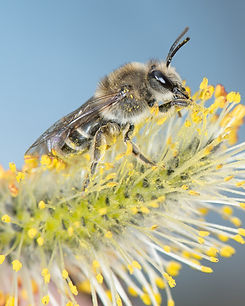
Family Megachilidae
Megachilidae
In Minnesota, the family Megachilidae includes fourteen bee genera: Anthidiellum, Anthidium, Ashmeadiella, Chelostoma, Coelioxys, Dianthidium, Heriades, Hoplitis, Megachile, Osmia, Paranthidium, Pseudoanthidium, Stelis, and Trachusa. Two of these genera—Coelioxys and Stelis—are cleptoparasitic (cuckoo) bees with hosts that include other bee genera in the family Megachilidae. Females in this family (other than the cuckoo bees) share a common trait: They carry pollen on hairs on the underside of their abdomen. This trait is unique to the family Megachilidae; nest-building bees in the remaining five families in Minnesota (and North America) carry pollen on their hind legs (or internally as is the case for Hylaeus). In addition to the scopal (pollen-collecting) hairs on the underside of the abdomen, Megachilidae also have two forewing submarginal cells and large mandibles often used for collection or manipulation of the supplemental nesting materials.
Megachilidae nest in a variety of sites; a majority of species nest aboveground in a pre-existing or excavated cavity, and a minority belowground, often in shallow burrows. This family includes many bee genera that source nesting materials to line and cap their nest, or create free form nests. The materials a given species may source include: mud, wood fiber or fragments, plant hairs, plant resin, leaves, and pebbles. The plants used to source these nesting materials are a critical habitat component for each bee species. Lastly, this family includes many pollen-collecting specialists (oligolectic bees).

Stelis lateralis visiting Achillea millefolium.

An Osmia lignaria female visiting Geranium maculatum.
Family Characteristics

Females collect pollen on hairs on the underside of the abdomen; mandibles large.

Medium to long glossa (tongue) 5 to 12 mm (0.2 to 0.4 in).

1
2
Two forewing submarginal cells.

Males often with last abdominal segments turning downward and/or last segment with tooth-like projections.
Explore Megachilidae Genera
Note: Two genera/species on the state list are not included in this guide: Ashmeadiella bucconis (last seen in Minnesota in 1949) and Trachusa zebrata (last seen in Minnesota in 1939). If either of these genera/species is rediscovered in the state, they will be added to the guide at that time.
Explore Bee Families

Apidae
15 genera, 133 species
Bumble bees Bombus
Longhorn bees
Epimelissodes, Eucera, Melissodes
Carpenter bees
Ceratina, Xylocopa
Honey bees Apis
Digger bees Anthophora
Cuckoo bees Brachymelecta, Epeolus, Holcopasites, Nomada, Neolarra, Triepeolus
Squash bees Xenoglossa

2 genera, 39 species
Halictidae
10 genera, 133 species
Metallic green sweat bees
Agapostemon, Augochlora, Augochlorella, Augochloropsis
Large sweat bees
Dieunomia, Nomia
Short-faced bees Dufourea
Sweat bees Halictus
Small sweat bees Lasioglossum
Cuckoo (blood) bees Sphecodes
Megachilidae
14 genera, 86 species
Resin and pebble bees Anthidiellum, Dianthidium, Heriades, Paranthidium
Carder bees Anthidium, Pseudoanthidium
Mock orange bees Chelostoma
Mason bees Osmia, Hoplitis
Leafcutter bees Megachile
Sharp-tailed cuckoo bees Coelioxys
Dark cuckoo bees Stelis

Citations and Further Reading
Droege, S., et al. (2024). The Very Handy Bee Manual: 2.0. How to Catch and Identify Bees and Manage a Collection.
Gibbs, J., Hanuschuk, E., Miller, R., Dubois, M., Martini, M., Robinson, S., ... & Onuferko, T. M. (2023). A checklist of the bees (Hymenoptera: Apoidea) of Manitoba, Canada. The Canadian Entomologist, 155, e3.
Mitchell, T. B. (1960). Bees of the eastern United States. Technical Bulletin No. 141. North Carolina Agricultural Experiment Station.
Portman, Z. M., Gardner, J., Lane, I. G., Gerjets, N., Petersen, J. D., Ascher, J. S., ... & Cariveau, D. P. (2023). A checklist of the bees (Hymenoptera: Apoidea) of Minnesota. Zootaxa, 5304(1), 1-95.
Wilson, J. S., & Messinger Carril, O. J. (2016). The bees in your backyard: a guide to North America's bees. Princeton University Press.
Page Photography Credits
Heather Holm















